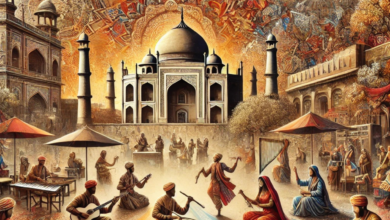Crafting Unique Narratives: Exploring the Power of “Your Topics | Multiple Stories”

Introduction
In a world overflowing with content, how do we create something that truly resonates? The answer lies in storytelling, a timeless art that connects people across cultures, generations, and platforms. But what happens when we move beyond single-threaded narratives and embrace the concept of “Your Topics | Multiple Stories“? The result is a transformative approach to storytelling that captivates, informs, and inspires like never before.
The power of multiple stories lies in their ability to weave diverse perspectives into a cohesive narrative. This approach not only enhances audience engagement but also ensures broader relatability. In this article, we delve into what “Your Topics | Multiple Stories” means, its applications across various fields, and how to create compelling multi-narrative content.
What Does “Your Topics | Multiple Stories” Mean?
At its core, “Your Topics | Multiple Stories” refers to presenting a central theme through several interconnected narratives. This method allows audiences to see a topic from different angles, fostering a deeper understanding and emotional connection. Instead of offering a single perspective, it invites readers, viewers, or listeners to explore the multifaceted nature of a subject.
Historically, this concept has been embedded in storytelling traditions. Folklore, for instance, often features interconnected tales that build upon each other to convey moral lessons. In modern contexts, this approach has found a home in diverse formats like anthology series, case studies, and multi-perspective novels. The thematic flexibility of this approach ensures it can be adapted to virtually any subject, whether it’s a scientific breakthrough, a marketing campaign, or a personal journey.
The benefits of using multiple stories are substantial. They enhance relatability by addressing various audience demographics and experiences. Moreover, they provide a holistic view, making complex topics easier to comprehend and more engaging to explore.
Applications Across Domains

Education
In education, storytelling is a proven tool for enhancing learning. Presenting a topic through multiple narratives—such as case studies or real-life scenarios—helps students grasp concepts more effectively. For example, teaching history by exploring the perspectives of different historical figures brings the past to life, fostering empathy and critical thinking. This method also encourages students to connect theoretical knowledge with real-world applications, making lessons more memorable.
Business and Marketing
Businesses and marketers have long understood the value of storytelling. A multi-narrative approach allows brands to connect with a diverse audience by showcasing various customer experiences or campaign angles. For instance, a company selling fitness gear might share stories from professional athletes, fitness enthusiasts, and beginners alike. This strategy builds trust, as audiences see themselves represented in the narratives, leading to stronger brand loyalty.
Entertainment and Media
The entertainment industry thrives on multi-threaded storytelling. From anthology TV series like Black Mirror to books with multiple protagonists, this approach keeps audiences hooked by offering fresh perspectives within a single framework. Similarly, video games with interactive storytelling let players shape the narrative, creating a deeply immersive experience. By presenting different stories, creators ensure their work appeals to a wide audience while maintaining thematic unity.
Mental Health and Advocacy
In mental health and advocacy, sharing diverse stories is essential to breaking stigma and fostering understanding. Platforms like blogs, podcasts, and social media allow individuals to share their experiences, creating a tapestry of voices that highlight the complexities of mental health issues. These narratives not only empower individuals but also encourage empathy among readers and listeners, driving meaningful social change.
Crafting Compelling Multi-Narrative Content
Choosing the Right Topics
The foundation of a successful multi-narrative story lies in selecting topics that resonate with your audience. Researching their interests, pain points, and aspirations ensures your content remains relevant and engaging. Tools like surveys, analytics, and social media insights can help you identify themes that hold broad appeal.
Building Interconnected Stories
Creating seamless transitions between narratives is key to maintaining audience engagement. Each story should contribute to the overarching theme, ensuring coherence while allowing each perspective to shine. Techniques like recurring motifs, parallel timelines, or shared characters can help tie individual narratives together.
Engaging the Audience
Interactivity is a powerful way to captivate your audience. Incorporate elements like polls, Q&A sessions, or “choose your path” stories to make your content more dynamic. Multimedia elements such as videos, infographics, and podcasts further enhance the experience by appealing to different learning styles.
Common Pitfalls to Avoid
While multi-narrative storytelling offers numerous benefits, it’s not without challenges. Overcomplicating the structure can confuse audiences, detracting from the core message. Similarly, redundancy between stories can dilute their impact. To avoid these pitfalls, ensure each narrative adds unique value and stays aligned with the central theme.
Conclusion
In today’s content-rich world, “Your Topics | Multiple Stories” offers a refreshing and impactful approach to storytelling. By weaving diverse perspectives into a cohesive narrative, creators can connect with audiences on a deeper level, fostering engagement, understanding, and loyalty.
Whether you’re an educator, marketer, artist, or advocate, the possibilities of multi-narrative storytelling are endless. So, take the plunge, explore new perspectives, and create stories that truly resonate. After all, the future of storytelling lies in its ability to adapt and connect with a diverse, ever-evolving audience.
FAQs
What is the significance of using multiple stories for one topic?
Using multiple stories provides diverse perspectives, enhancing relatability, understanding, and engagement for a wide range of audiences.
How can businesses benefit from this approach?
Businesses can use multi-narrative storytelling to connect with various customer segments, showcase diverse experiences, and build emotional connections.
Are there challenges in crafting multi-narrative content?
Yes, challenges include maintaining coherence, avoiding redundancy, and ensuring that each story contributes value to the overarching theme.
What tools can help in creating interconnected narratives?
Storyboarding software, collaborative writing platforms, and multimedia tools can streamline the process of crafting multi-narrative content.
Can this approach work for solo content creators?
Absolutely! Solo creators can draw from personal experiences or collaborate with others to present diverse perspectives within a single topic.
You May Also Read: https://bestusatime.com/sky-news-arabia/



